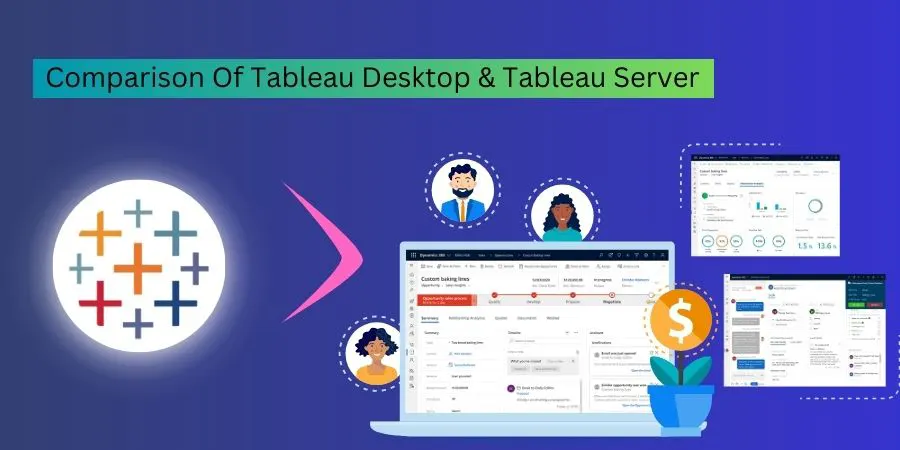
Tableau is a competent data visualization tool that helps users analyze, visualize, and share data in a user-friendly and interactive manner. Tableau offers two pivotal products: Tableau Desktop and Tableau Server. While both products serve distinct purposes, they are often used together to construct a seamless workflow, from data exploration to sharing insights with others.
Tableau Desktop
Tableau Desktop is the flagship product of Tableau development services, designed for individual users, analysts, and data scientists. It empowers users to connect to distinct data sources, transform and clean data, and construct visually appealing dashboards and reports.
Data Connection And Transformation
Tableau Desktop offers a wide range of connectors to connect to distinct data sources. Users can connect to live data sources or import data for offline analysis. The data connection capabilities of Tableau Desktop make it effortless to access and combine data from different sources, enabling comprehensive data analysis.
In addition to data connections, Tableau Desktop offers powerful data transformation capabilities. Users can perform data cleansing, filtering, and calculations within the tool, eliminating the need for external data preparation tools. This flexibility will permit users to shape their data to meet specific requirements and ensure accurate analysis and visualization.
Drag-and-Drop Visual Analysis
Tableau Desktop provides an intuitive drag-and-drop interface that permits users to construct interactive visualizations without writing complex code. Users can simply drag data fields onto the canvas, choose from a variety of chart types, and customize the appearance of the visualization. The visual analysis capabilities of Tableau Desktop make it easy for users to explore data, detect patterns, and uncover insights quickly.
Calculations And Advanced Analytics
Tableau Desktop offers a wide range of built-in calculations and advanced analytics features. Users can create calculated fields, use statistical functions, perform aggregations, and apply filters to perform in-depth analysis. Additionally, Tableau Desktop supports integration with R and Python, permitting users to leverage the power of these programming languages for advanced analytics and predictive modeling.
Interactive Dashboards And Storytelling
One of the primary perks of Tableau Desktop is its ability to construct interactive dashboards and compelling data stories. Users can combine multiple visualizations into a single dashboard, add interactivity, and design a seamless user experience. Furthermore, Tableau Desktop will permit users to construct interactive presentations where they can guide viewers through a series of visualizations and narratives to convey insights effectively.
Tableau Server
While Tableau Desktop focuses on individual data analysis and visualization, Tableau Server takes it a step further by enabling collaboration, sharing, and governance within organizations. Tableau Server permits users to publish their Tableau Desktop workbooks and data sources to a centralized server, making them accessible to a broader audience.
Centralized Data Governance
Tableau Server offers a centralized platform for managing and governing data assets within a firm. Administrators can control access to data sources, workbooks, and dashboards. Additionally, Tableau Server offers granular permissions and security settings, permitting administrators to define roles and manage user access effectively.
Browser-Based Access And Interactivity
One of the primary perks of Tableau Server is that it permits users to access Tableau workbooks and dashboards using a web browser. It will eliminate the need for Tableau Desktop installation on individual machines, making it easier for non-technical users to explore and interact with data.
Tableau Server also provides interactive features, enabling users to perform analysis and gain insights directly from the browser interface.
Collaboration And Content Management
Tableau Server facilitates collaboration among team members by offering features. Moreover, Tableau Server includes content management capabilities, permitting users to organize and categorize dashboards, workbooks, and data sources into projects or folders for easy navigation and discoverability.
Scalability And Performance
Tableau Server is designed to handle large-scale deployments and support a growing number of users and workloads. It offers scalability options such as distributed deployments and load balancing, ensuring high availability and optimal performance. Additionally, Tableau Server provides caching and data extraction mechanisms, permitting faster response times and enhanced performance, especially when dealing with large datasets.
Automated Data Refresh And Scheduling
Tableau Server enables automated data refresh and scheduling, ensuring that the published dashboards and reports are always up-to-date. Users can set up data source connections to refresh at specific intervals, ensuring that the visualizations reflect the latest data. This feature will eliminate the manual effort of refreshing data and ensure that stakeholders always have access to the most recent insights.
Tableau Desktop vs. Tableau Server: Which One To Opt For?
The choice between Tableau Desktop and Tableau Server will depend on a firm’s requirements and the intended use case. Here are a few pivotal considerations
If you are a data scientist or an individual analyst who needs to explore and visualize data, Tableau Desktop is an ideal choice. It provides a rich set of features for data analysis, visualization, and advanced analytics. With Tableau Desktop, you have complete control over your data and can construct sophisticated visualizations tailored to your needs.
If you want to share your Tableau workbooks and insights with others, collaborate within your firm, or enable browser-based access for non-technical users, Tableau Server is the way to go. Tableau Server enhances collaboration, data governance, and scalability, making it suitable for firms that require centralized management and want to share insights across teams and departments.
In many cases, firms employ Tableau Desktop for individual data analysis and visualization and Tableau Server for publishing and sharing the created content. This combination will offer the best of both worlds, permitting users to leverage the power of Tableau Desktop for data exploration while benefiting from the collaboration and sharing capabilities of Tableau Server.
Conclusion
In conclusion, Tableau Desktop and Tableau Server are two complementary products that cater to different needs within the data analytics workflow. Tableau Desktop empowers individual users with data exploration and visualization capabilities, while Tableau Server enables collaboration, sharing, and governance at scale.
By comprehending their features and use cases, you can opt for the ideal tool or combination of tools to unlock the full potential of your data and empower your firm with actionable insights.